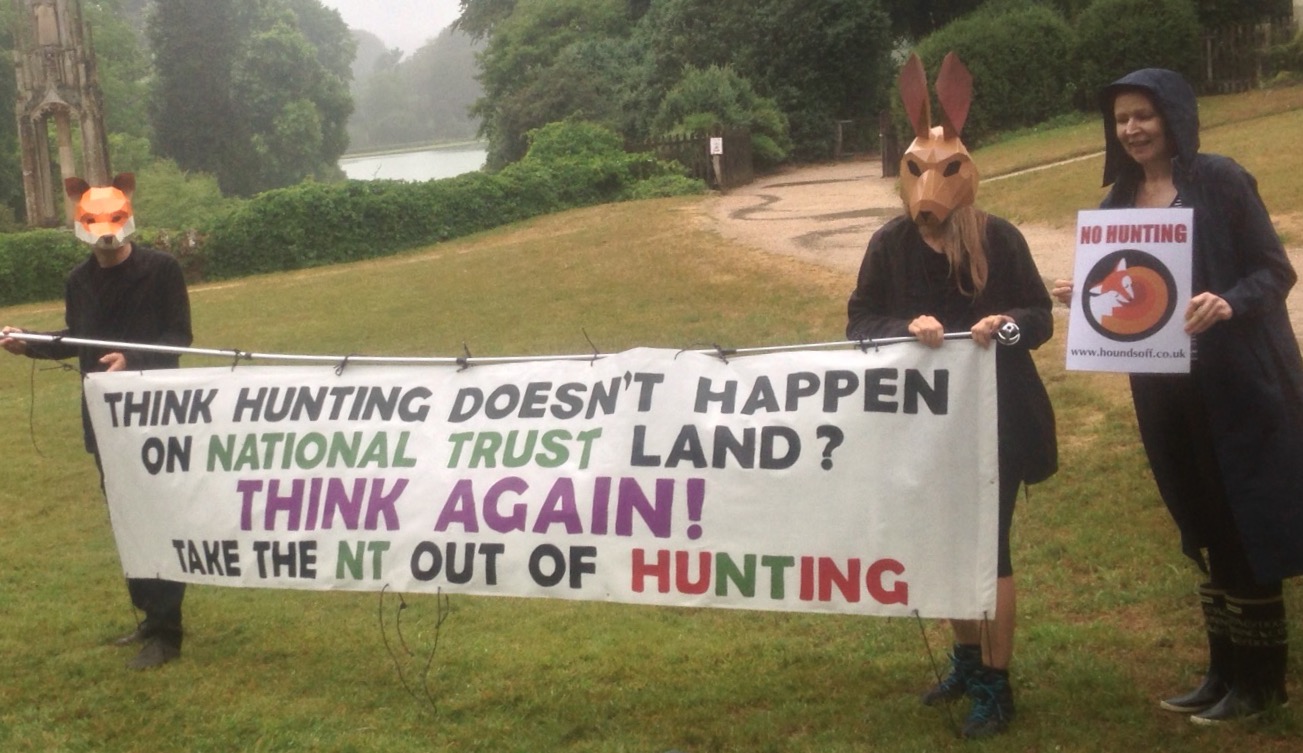30th October 2018
PRESS RELEASE: Stag hunting in Somerset Oct 2018
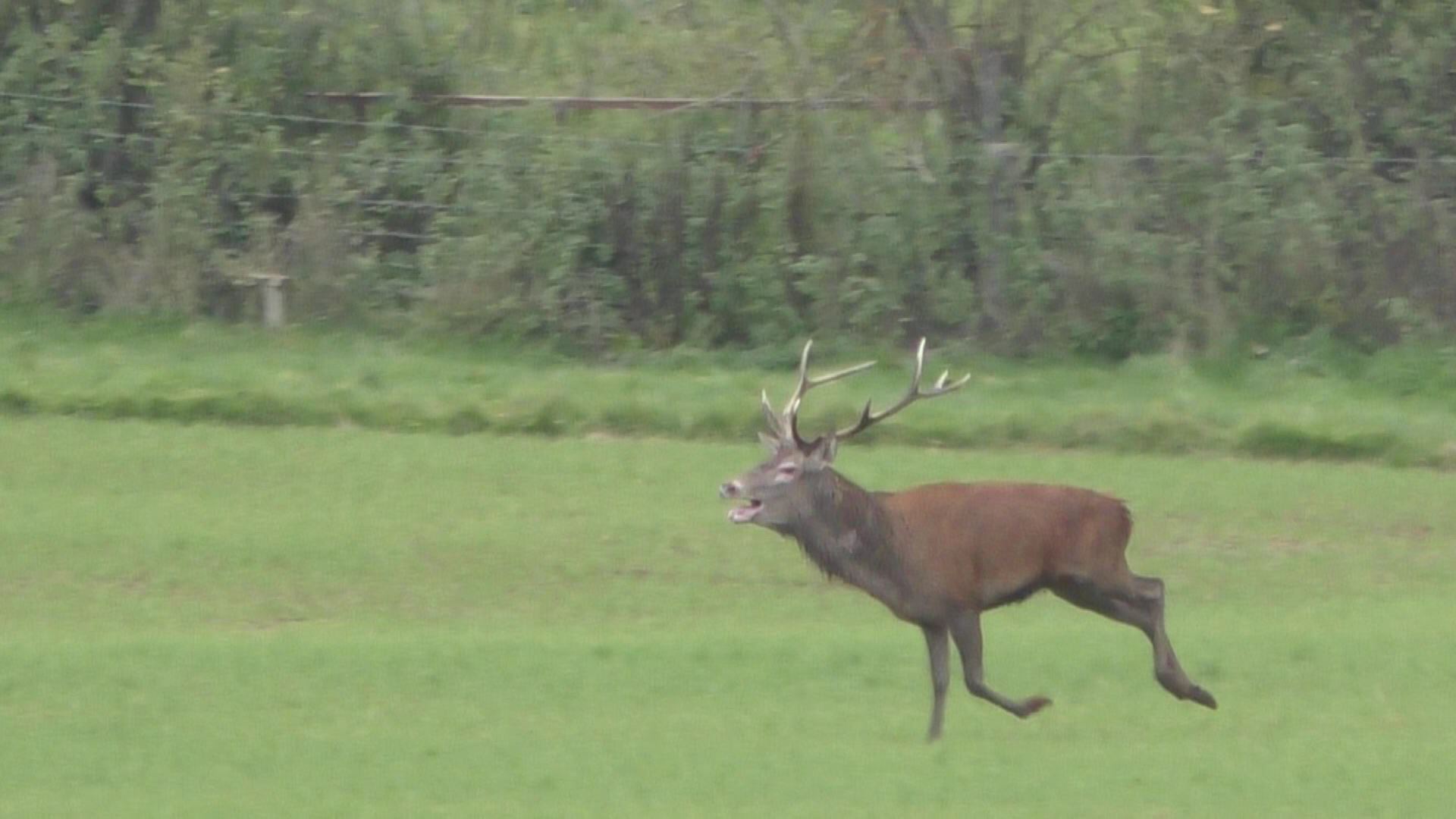 Hunted stag runs for his life. Quantock Stag Hounds, 25.10.18
Photo credit: Hounds Off
Hunted stag runs for his life. Quantock Stag Hounds, 25.10.18
Photo credit: Hounds Off
SHOCKING FOOTAGE EMERGES OF STAG HUNTING JUST TEN MILES FROM TAUNTON
- Campaigners have released shocking footage of a Red deer stag being hunted by the Quantock Stag Hounds in Somerset on Thursday 25 October 2018.
- The hunt took place about ten miles from Taunton near the picturesque West Somerset Railway line at Crowcombe Heathfield and lasted for three hours.
- Hunters used combination of horse riders, dogs and four wheel drive vehicles to harass and harry the stag through woods for nearly two hours before forcing him out into the open, and on his own, for another hour.
- After being flushed from the woods, film clearly shows the stag running with his mouth gasping and tongue lolling. There is a heaviness to his gait.
- About an hour later two hounds, which had been set to follow the stag by scent, have chased him to exhaustion. The stag is ‘at bay’ behind a tree in undergrowth. Hounds can be clearly seen ‘marking’ their target; barking incessantly, rushing forwards and jumping back as the stag uses his antlers to keep them from attacking.
- Gunmen from the Quantock Stag Hounds get within close range but the stag jumps up and makes a bid to escape. Hounds give chase and five minutes later, away from cameras, the stag is killed.
- Hunt followers and riders gather in the woods for the traditional carve-up, where the body is divided into trophies for people to take away and remember their day.
Many people think that stag hunting was banned when the Hunting Act (2004) made chasing and killing most wild mammals with dogs illegal. But it hasn’t quite worked out like that. Stag hunters in the West Country have reinvented their bloodsport with subtle differences which allow them to exploit loopholes and exemptions which circumvent the law, including;
- Claiming to be conducting Research & Observation according to Schedule 1 (9) of The Hunting Act (2004), in the same way as Japanese and other whaling nations carry on killing under the pretence of scientific research.
- The Research exemption was intended to enable scientists to carry out their studies if they needed dogs to find a wild mammal. But it does not specify that people claiming Research under this exemption have to be scientists, that their research has to be genuine or that it should be non-lethal.
- The Observation part only requires a hunter to be looking at the stag when it is killed.
- Flushing to guns. The Hunting Act (2004) provides for this in Schedule 1 (1), so long as only two hounds are used and the stag is shot as soon as possible.
NOTES FOR EDITORS
- The National Trust banned stag hunting in 1997 after Professor Patrick Bateson published a report which found that hunting deer with hounds inflicted cruelty and distress far beyond anything they might experience in nature.
- Stag hunting was prohibited on Forestry Commission land in 1997 too.
- Campaigners have documented numerous incidents of trespass by the Quantock Stag Hounds on National Trust and Forestry Commission land during September and October 2018.
- The Quantock Stag Hounds hunt deer with dogs Mondays and Thursdays throughout September to April.
For more information or interviews please contact:
Bobbie Armstrong
Somerset Wildlife Crime: 07572495309
Joe Hashman
Hounds Off: 07711 032697
18th October 2018
Government Defends Wildlife Crime On Public Land
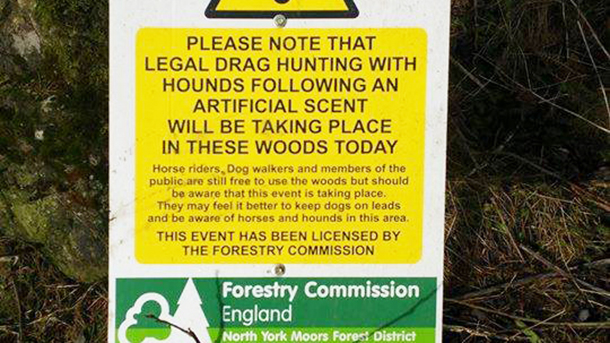 Forestry Commission sign warning of a 2016 drag hunting event at North York Moors, where no actual drag hunt operates. Photo courtesy International Fund for Animal Welfare
Forestry Commission sign warning of a 2016 drag hunting event at North York Moors, where no actual drag hunt operates. Photo courtesy International Fund for Animal Welfare
GOVERNMENT DEFENDS WILDLIFE CRIME IN PUBLICLY OWNED FORESTS
Yesterday, the Department for Environment, Food & Rural Affairs responded to a petition calling for an end to the licensing of so-called ‘trail hunts’ on the Public Forest Estate, which is owned & managed by the Forestry Commission on behalf of the public. The response is pretty much a paraphrased Countryside Alliance press release and there are a couple of things they’ve either overlooked, perhaps accidentally, perhaps not:
- The petition specifically doesn’t call for an end to licences given to hunts which have agreements formed under a general agreement with the Master of Draghounds & Bloodhounds Association (MDBA), as drag hunting & clean boot hunting are not covers for wildlife crime.
- DEFRA’s response omits that licences are also granted to hunts under a general agreement with the Association of Masters of Harriers & Beagles (AMHB), such as the New Forest Beagles.
Most importantly, though, they’ve regurgitated one of the most worn out lies in the country and they’ve done so without scrutiny. This is, of course, that fox & hare hunts have stopped hunting live quarry and started to ‘trail hunt’.
‘Trail hunting is a legitimate activity … Many hunts have since turned to trail hunting as an alternative to live quarry hunting…’ – DEFRA, 17th October 2018.
Here’s a couple of brief reasons why this is rubbish:
- In 2014, a review of RSPCA prosecuting activity was published by Stephen Wooler CB, a former Chief Inspector for the Crown Prosecution Service. On P109/s9.1 it stated that: ‘The evidence reviewed leaves no room for doubt that, despite the 2004 legislation, traditional fox hunting remains “business as usual” in many parts of the country.’
- Both before & after the Wooler Review, hunts that have been licensed to use public land by the Forestry Commission have been convicted; the Meynell & South Staffordshire Hunt were convicted under the Hunting Act 2004 based on footage from Derby Hunt Saboteurs and the Cottesmore Hunt were convicted under the Protection of Badgers Act 1992 based on footage from the League Against Cruel Sports.
DEFRA have rejected the requests of the petition on a completely false premise. It remains open & ongoing to gain signatures, and needs 100,000 signatures before 18th March 2019. If you haven’t signed this already, please do so here!
© Jack Riggall
13th October 2018
Game Of Cat & Mouse Continues #TrailHuntLies
HOUNDS OFF OPINION
The National Trust has started issuing licences for foxhunt packs to carry out so-called trailhunting on their land. But this season the business-as-usual status quo has changed slightly. Licences will now be open to public scrutiny and a small team has been appointed to oversee this activity. For many this is not enough, for others it’ll be too much.
Myself, I’m a realist. I know the National Trust is a huge chuntering juggernaut of a conservation charity which must cater for a wide spectrum of opinions and beliefs. I know how frustratingly slow it can be to effect positive change but I also recognise that the National Trust has a history of being led by its Members and it is always worth using your voice and your vote.
So it was that on Friday 12 October I travelled to Birmingham and, with Jack Riggall from National Dis-Trust, met with Nick Droy and Rob Rhodes from the National Trust. Nick is five weeks into his role of Trailhunting Manager and Rob (who attended via telephone) is the Head of Countryside Management & Rangers.
Trailhunting Manager is a new post, created by the National Trust in response to concern from Members and the public that trailhunting is nothing more than a false alibi used to provide a cover for illegally chasing and killing wild mammals with dogs.
Nick told us that his professional background is in practical countryside management at both regional and national levels and it started eighteen years ago when he was himself a National Trust volunteer. He explained that he has no hunting in his background and is approaching this complex issue with a fresh eye and open mind.
Nick will lead a team of three; an office-based co-ordinator and a worker who will assist in carrying out face to face engagements, checks in the field and monitoring of so-called trailhunting on National Trust land.
This season, the Trailhunting Team will be conducting one pre-arranged inspection of each Hunt which is granted a licence by the National Trust. My problem with this is that it provides an easy way for #TrailHuntLies to avoid detection because when Nick is about Hunts will temporarily change the way they behave.
I told Nick and Rob this and referred them to a 2015 report called Trail Of Lies. It is a fantastically complete and in-depth exposé of how Hunts have used trailhunting to circumvent the law, to carry on abusing and killing. The only problem with Trail Of Lies is that it was complied and produced by the International Fund for Animal Welfare and so hunters consider it to be propaganda.
It is not and, to reinforce the point, I signposted the National Trust Trailhunting Manager to another, independent, source which reaches the same conclusion; the Wooler Review.
What happened was the RSPCA had grasped the nettle in terms of taking private Hunting Act prosecutions and landed seminal convictions against the prestigious Heythrop Hunt in 2012. The Countryside Alliance went ballistic and set out to destroy their opponents.
Their criticism reached a crescendo in January 2013 when former Countryside Alliance head honcho Simon Hart MP initiated a debate in the House of Commons about prosecutions brought by the RSPCA and in response Her Majesty’s Attourney General suggested that an independent review could be advantageous. The RSPCA Council took heed and appointed Stephen Wooler CB to do this. Wooler is a Barrister and former Chief Inspector to the Crown Prosecution Service.
During our meeting I read a passage from the Wooler Review and asked Nick to think of his Trailhunting Team as being the police officers to which Wooler refers;
“Securing the evidence neccasary to mount effective prosecutions under the Hunting Act 2004 in respect of mainstream foxhunting therefore requires far more than sending a team of police officers to take the names and addresses of those at a hunt gathering. The evidence required is such that it is unlikely to be achieved through police presence and observations alone since behaviours would then be likely to change.” (1)
In fact, Wooler goes on to describe a “cat and mouse game between hunting participants and supporters and those endeavouring to gather evidence through observations and recordings.” (2)
I concur with Wooler (2014) and Trail Of Lies (2015): giving hunters a heads-up when they’ll be monitored on National Trust land is rather like the police telling a burglar when they’ll be round to look for stolen goods.
As Trailhunting Manager, it is part of Nick Droy’s job description (and background research) to meet with the likes of Jack and myself. I found him to be friendly, open and likeable. That’s a good start, but I do believe that there are fundamental flaws in how the National Trust have instructed him to carry out his duties. We agreed to keep lines of communication open and meet again next summer. Doubtless much will happen between now and then.
© Joe Hashman
References:
(1) The independent review of the prosecution activity of the RSPCA, Stephen Wooler CB, 2014. Page 110, paragraph 5.
(2) The independent review of the prosecution activity of the RSPCA, Stephen Wooler CB, 2014. Page 110, paragraph 6.
Hounds Off is run by volunteers. We rely on public support to fund our work. If you would like to contribute .
Costs incurred on 12 October 2018;
Return travel by road from Dorset to Oxford (179 miles at 44 pence per mile) = £78.76; Oxford to Birmingham New Street return, by train (Adult Standard Class) = £79.20; Total = £157.96
9th October 2018
Staghunting On The Quantock Hills 08.10.18
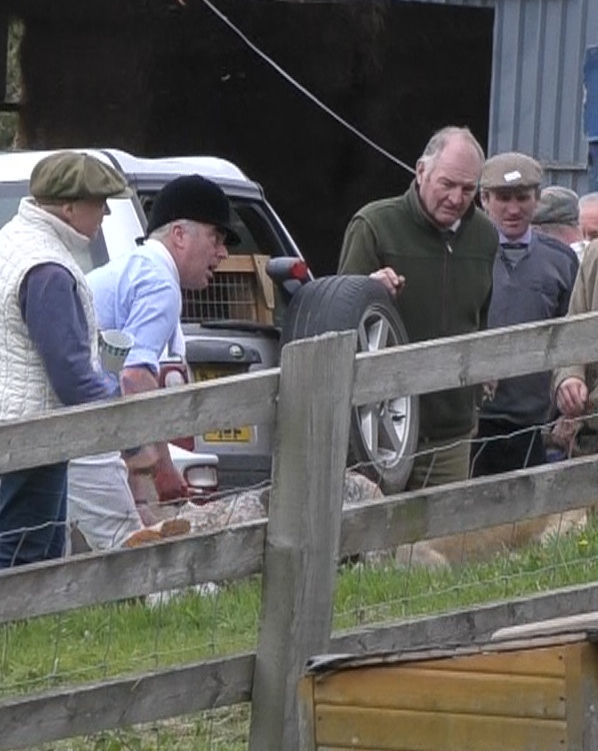 Scene from Quantock Stag Hounds carve up at Staple Farm, West Quantoxhead, Somerset, 8 October 2018.
Scene from Quantock Stag Hounds carve up at Staple Farm, West Quantoxhead, Somerset, 8 October 2018.
There was a moment yesterday when I thought that the Quantock Stag Hounds had decided not to go hunting but alas it wasn’t so. In the end they killed a stag and took the body to a farm to carve it up. Men and women supped cans of drink and watched in gory fascination as the Huntsman, elbow deep in warm blood, dished out bits of inneds and butchered the animal at their feet, in front of their eyes.
They started not far from Bishops Lydiard which itself is a stones throw from Taunton. I was part of a team of Hunt Monitors. We were parked near the beauty spot of Lydiard Hill, by some horseboxes. We anticipated that the Hunt would come in this direction.
Shortly after 11am my radio crackled and the message came through that there was movement our way. Then a gaggle of hunt riders came along the lane, gave us a bit of verbal, loaded their horses into the boxes, and drove off. That was when, fleetingly, I vain hoped they were going to leave stags on the Quantock Hills in peace.
Instead, the Hunt relocated. We got a message that they were up Crowcombe and sure enough that’s where they were hunting.
Staghunting on the Quantocks is not what it was. Prosecutions, campaigning pressure and changing attitudes from the police have forced them to stop using a pack of a dozen or more hounds to chase stags to exhaustion. This season, which started at the end of August, they’ve been using two hounds and an army of riders and vehicle followers to chase and chaperone their quarry. It’s a tactic which staghunters on Exmoor have employed for years now and I think they believe it exempts them from prosecution under the Hunting Act.
There were a couple of huntable stags in Crowcombe Park but an especially big fellow was the target. It took a while for the Hunt to flush him up onto the hills but eventually their pressure forced him out.
I was tracking the Quantock Stag Hounds (QSH) in a vehicle, in communication with others who were both mobile and on foot. From hilltops you get some fantastic views but the Quantock Hills are characterised by large blocks of woodland and numerous steep, deep valleys known as ‘combes’. The staghunters know this landscape intimately and are skilled at operating simultaneously in the open yet out of sight, if that makes sense.
The stag was somewhere below a high spot called Bicknoller Post. Horsemen and women lined the tracks and combe sides. The stag didn’t appear keen to run. It’s mating season for Red deer in Devon and Somerset (the ‘rut’) so likely he was pretty tired from all that. I thought they were going to shoot him there and then but no, they wanted some sport.
What followed was not a high speed, high adrenalin gallop and chase over the countryside. It was more akin to a slow walk. The stag kept low among whatever cover he could find to hide in and the hunters, co-ordinated by radios and aided by their two dogs, pushed the deer along and steered him away from our eyes and camera lenses.
We drove into the picturesque village of Holford. By now we had a hunt supporter tailing us. We waited to let a party of schoolchildren pass. I hoped they saw the anti hunting stickers in the car window and that’s why they smiled and waved and shouted hello as adults in yellow tabbards shepherded them safely to the side. Or, more likely, they were just naturally excited to be exploring such a beautiful place.
A sharp right and left and we were in the car park with dog walkers and tourists. Our hunt tail parked up herself and ran to keep tabs on the foot team we deployed. I drove up a remote, single track lane and at the end was a gathering of elderly hunt supporters in cars.
A number of wooded combes with streams converge at Holford and in the recent past it was a favourite killing place for the QSH. But these days they are no longer Kings of the Hills. They skulk more. Red coats have been swapped for fawny brown. They’re quieter. They still take up a lot of space but they try to avoid clogging villages with four-wheel drives and quad bikes. They are adept at chaperoning their stag quite discreetly away from public gaze.
There were moments while we were in Holford. We heard the hunting horn and urgent, loud shouting. Vehicles travelled at dangerous pace on bumpy lanes back and forth. But nothing more than that came our way.
Our teams of Hunt Monitors communicate by walkie-talkie and telephone, neither of which work well in this area of Somerset. It’s hard to be in the right place at the right time anyway but when communications are poor because the signal isn’t great it’s even harder. We believed that the hunted stag had left the Hills for farmland near Kilve but weren’t sure.
The stag was killed south of the A39 near Kilve late in the afternoon, in the depths of private property, and taken to a nearby farmyard for the post-orgasmic ‘carve up’. They were not happy about us trying to take some pictures and it was difficult anyway as they’d hidden themselves behind buildings. Out of sight but not out of our minds.
That was the bloody reality of staghunting on the Quantock Hills this day, 8th October 2018.
Volunteers from Hounds Off and Somerset Wildlife Crime continue to monitor staghunting on the Quantocks, bear witness and gather evidence to show how hunts are operating. You can . Mark your donation ‘QSH’ and we will dedicate it to this specific fund.
© Joe Hashman
6th October 2018
Spot The Difference
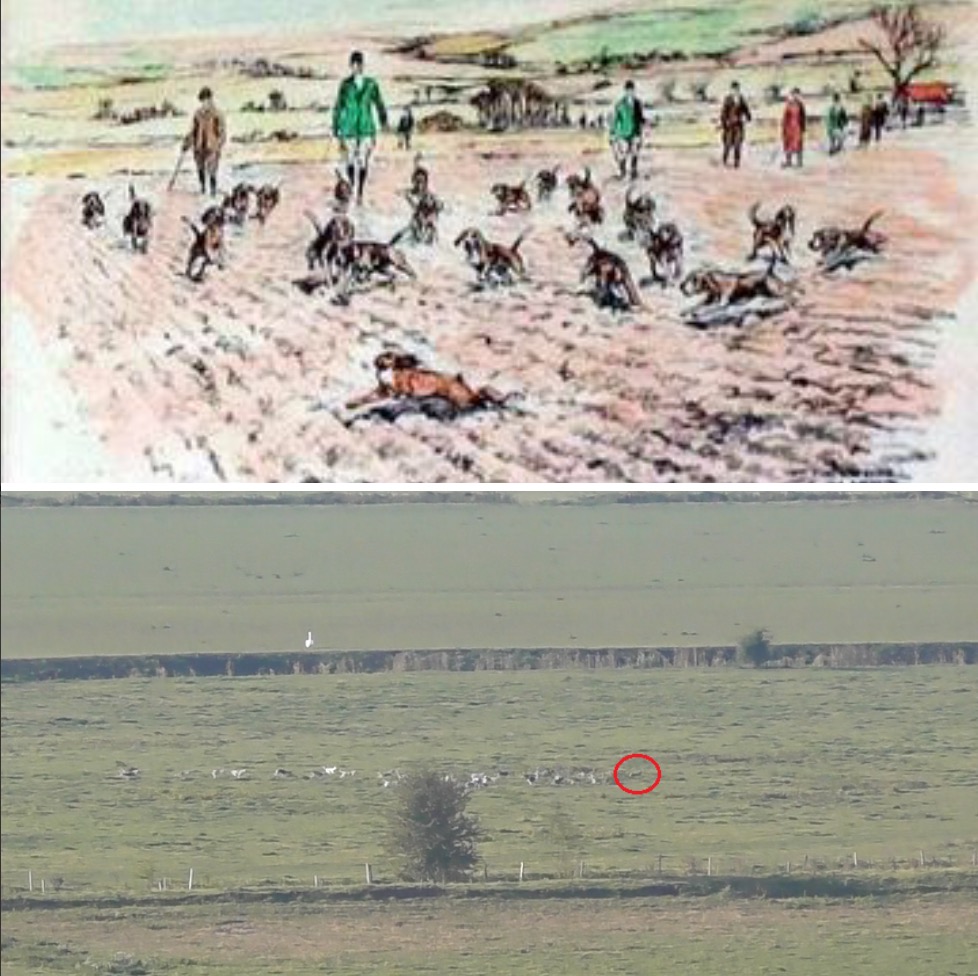 Top: 'The First Essential Towards Sport' by Tom Ilvester Lloyd (1873-1942). Bottom: Ilminster Beagles from Bineham City Farm, near Ilchester, Somerset, 29 September 2018.
Top: 'The First Essential Towards Sport' by Tom Ilvester Lloyd (1873-1942). Bottom: Ilminster Beagles from Bineham City Farm, near Ilchester, Somerset, 29 September 2018.
You could be forgiven for wondering why the Ilminster Beagles are not getting done for illegal hunting because film of them finding and chasing hares on 29 September 2018 is quite clear. The problem is that hunters have found cunning ways to avoid the law and one of their dishonest excuses is to cry “Accident!”
What the film of hare hunting near Langport, Somerset shows is the beagle pack searching for, finding and pursuing a hare. The dogs are sniffing around seeking the scent of their quarry when suddenly the hare jumps up from right under their noses and sprints away as the beagles start barking excitedly and giving chase.
This is exactly how many hare hunts started before the Hunting Act came in to force in 2005 so why are they not liable? Well, there is a subtle difference which provides an excuse that gets them off the hook. Read on.
Look at the pictures at the head of this blog. Toppermost is a painting by avid sporting artist Tom Ilvester Lloyd (1873-1942). It portrays “the find”, that moment when a hare springs up literally in front of hounds and the hunt begins. Ilvester Lloyd entitled his work The First Essential Towards Sport which says it all, really.
Now look at the grab below, taken from film of the Ilminster Beagles on 29 September 2018. This also captures the precise second when a hare is found and forced to make a run for it. It’s a post-ban, real-life version of The First Essential Towards Sport.
The reason why the Hunting Act cannot be enforced on the Ilminster Beagles is because in the evidence there are no humans in shot and therefore the Huntsman can claim that hunting of the hare took place by accident. Alas, thanks to a fundamental desire to circumvent the law and some unfathomable decisions in the Courts, crying “Accident!” is a get-out-of-jail card which hunters up and down the country are playing every time they go out.
Interestingly, when the hunted hare runs close to roe deer and the Ilminster Beagles switch to following them, hunt staff are close enough to be able to stop them and prevent a riot.
It’s a shame that the police are so under-resourced. A little targeted training would help them understand why and how huntsmen and women across the land are cocking a snook at them (and us) and go a long way to preventing wildlife crime in the first place.
Illegal hunting by the Ilminster Beagles on 29 September 2018 was reported to Avon & Somerset Police and is recorded with the following Incident Number: AS-20180929-0304.
WATCH OUR FILM OF BEAGLING IN 2018 here.
HOW FOXHUNT MASTER CLAIMED “ACCIDENT” TO AVOID PROSECUTION film and report here.
IF YOU SEE BEAGLING phone the police on 101 or 999. Make sure that they record your call and give you an Incident Number.
IF YOU HEAR ABOUT BEAGLING tell us! All information is treated in confidence.
© Joe Hashman
Online recommendations
- Best Casino Sites Not On Gamstop
- Online Casinos Not On Gamstop
- UK Betting Sites
- UK Online Casinos Not On Gamstop
- Gambling Sites Not On Gamstop
- Non Gamstop Casinos
- Sites Not On Gamstop
- Non Gamstop Casino Sites UK
- Non Gamstop Casino Sites UK
- Non Gamstop Casino Sites UK
- Non Gamstop Casino Sites
- Top Casino Sites UK
- Casino Not On Gamstop
- UK Online Casinos Not On Gamstop

